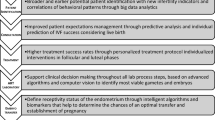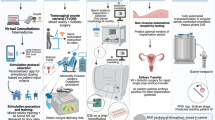Abstract
Decision-making in fertility care is on the cusp of a significant frameshift. Online tools to integrate artificial intelligence into the decision-making process across all aspects of ART are rapidly emerging. These tools have the potential to improve outcomes and transition decision-making from one based on traditional provider centric assessments toward a hybrid triad of expertise, evidence, and algorithmic data analytics using AI. We can look forward to a time when AI will be the third part of a provider’s tool box to complement expertise and medical literature to enable ever more accurate predictions and outcomes in ART. In their fully integrated format, these tools will be part of a digital fertility ecosystem of analytics embedded within an EMR. To date, the impact of AI on ART outcomes is inconclusive. No prospective studies have shown clear cut benefit or cost reductions over current practices, but we are very early in the process of developing and evaluating these tools. We owe it to ourselves to begin to examine these AI-driven analytics and develop a very clear idea about where we can and should go before we roll these tools into clinical care. Thoughtful scrutiny is essential lest we find ourselves in a position of trying to modulate and modify after entry of these tools into our clinics and patient care. The purpose of this commentary is to highlight the evolution and impact AI has had in other fields relevant to the fertility sector and describe a vision for applications within ART that could improve outcomes, reduce costs, and positively impact clinical care.




Similar content being viewed by others
Code availability
Not applicable.
References
Cohen J, Trounson A, Dawson K, Jones H, Hazekamp J, Nygren K-G, et al. The early days of IVF outside the UK. Hum Reprod Update. 2005;11:439–60.
Hajirasouliha I, Elemento O. Precision medicine and artificial intelligence: overview and relevance to reproductive medicine. Fertil Steril. 2020;114:908–13.
Hickman C, Aishubbar H, Chambost J, Jacque C, Pena C-A, Drakeley A, et al. Data sharing: using blockchain and decentralized data technologies to unlock the potential of artificial intelligence: what can assisted reproduction learn from other areas of medicine? Fertil Steril. 2020;114:927–33.
Hoffman PJ. The paramorphic representation of clinical judgment. Psychol Bull. 1960;57:116–31.
Jurisica I, Myleopoulos J, Glasgow J, Shapiro H, Casper RF. Case based reasoning in IVF: prediction and knowledge mining. Artif Intell Med. 1998;12:1–24.
Custers IM, Steures P, van der Steeg JW, Van Dessel TJHM, Bernardus RE, Bourdrez P, et al. External validation of a prediction model for an ongoing POR after IUI. Fertil Steril. 2007;88:425–31.
Kaufman SJ, Eastaugh JJ, Snowden S, Smye SW, Sharma V. The application of neural networks in predicting the outcome of in-vitro fertilization. Hum Reprod. 1997;12:1454–7.
Guvenir HA, Misiil G, Dibaz S, Ozedegirmenci O, Demir B, Dilbaz B. Esimating the chance of success in IVF treatment using rank algorithm. Mol Biol Eng Comput. 2015;53:911–20.
Pencina MJ, Goldstein BA, D’Agostino R. Prediction models-development, evaluation and clinical application. N Engl J Med. 2020;382:1583–6.
Garg AX, Adhikari NKJ, Rosas-Areliano MP, Devereaux PJ, Beyene J, Sam J, et al. Effects of computerized clinical decision support systems on practitioner performance and patient outcomes. J Amer Med Assoc. 2005;293:1223–38.
Medic G, Kleiss MK, Atallah L, Weichert J, Panda S, Postma M, et al. Evidence-based clinical decision support systems for the prediction and detection of three disease states in critical care: a systematic literature review. Artif Intell Med. 2019;8:1772.
Dissanayake PI, Colicchio TK, Cimino JJ. Using clinical reasoning ontologies to make smarter clinical decision support systems: a systematic review and data synthesis. J Amer Med Info Asso. 2020;27:159–74.
Dolan JO, Veezie PJ, Russ AJ. Development and initial evaluation of a treatment decision dashboard. BMC Med Informa Decis Making. 2013;13:51–7.
Letterie GS, Mac Donald AW. A computer decision support system for day to day management of ovarian stimulation during in vitro fertilization. Fertil Steril. 2020;114:1026–31.
Shen D, Wu G, Suk H-I. Deep learning in medical image analysis. Annu Rev Biomed Eng. 2017;2:221–48.
Greenspan H, Ginneken BV, Summers RM. Guest editorial deep learning in medical imaging: overview and future promise of an exciting new technique. IEEE Trans Med Imaging. 2016;35:1153–9.
De Fauw J, Ledsam JR, Romera-Paredes B. Clinically applicable deep learning for diagnosis and referral in retinal disease. Nat Med. 2018;24:1342–50.
Gulshan V, Peng L, Coram M, Stumpe MC, Wu D, Narayanaswamy A, et al. Development and validation of a deep learning algorithm for detection of diabetic retinopathy in retinal fundus photographs. J Amer Med Assoc. 2016;13:2402–10.
Cheung DS, Lim G. Prediction of cardiovascular risk factors from retinal fundus photographs via deep learning nature biomedical engineering development and validation of a deep learning algorithm for detection diabetic retinopathy in retinal fundus photographs. J Amer Med Assoc. 2016;316:2402–10.
Esteva A, Kuprel B, Novoa R, et al. Dermatologist-level classification of skin cancer with deep neural networks. Nature. 2017;542:115–8.
Coudray N, Santiago Ocampo P, Narula N, Snuderl M, Fenyö D, Moreira AL, et al. Classification and mutation prediction from non–small cell lung cancer histopathology images using deep learning. Nat Med. 2018;10:1559–67.
Lazzaroni-Tealdi E, Barad DH, Albertini DF, Yu Y, Kushnir VA, Russell H, et al. Oocyte scoring enhances embryo scoring in predicting pregnancy chances with IVF where it counts most. PLoS One. 2015;10:e0143632.
Rienzi L, Vajta G, Ubaldo F. Predictive value of oocyte morphology and human IVF a systematic review of the literature. Human Repro Update. 2011:1734–45.
Rienzi L, Ubaldi FM, Iacobelli M, Minasi MG, Romano S, Ferrero S, et al. Significance of metaphase to human oocyte morphology on ICSI outcome. Fertil Steril. 2008;90:1692–700.
Aragon J, Gonzalez AL, Yufera A. Applying image processing to in vitro human oocytes characteristics. In: Image Processing: Methods, Applications and Challenges; 2012. p. 1–17.
Basile TM, Caponetti L, Catellano G, Sforza G. Texture-based image processing approach for the description of human oocyte cytoplasm. IEEE Trans Instrum Meas. 2010;59:2591–601.
Bakas P, Bolaris S, Pantou A, Pantos K, Koutsilieris M. Are computational applications the “crystal ball” in the IVF laboratory? The evolution from mathematics to artificial intelligence. J Assist Reprod Genet. 2018;35:1545–57.
Nayot D, Meriano J, Casper R, Krivoi A. An oocyte assessment tool using machine learning: predicting blastocyst development based on a single image of an oocyte. Presented at ESHRE 2020. Accessed at: https://futurefertility.com/eshre-2020-abstract-ff/
Faramarzi A, Khalili MA, Ashourzadeh S. Oocyte morphology and embryo morphokinetics in an intra-cytoplasmic sperm injection programme. Is there a relationship? Zygote. 2017;25:190–6.
Braude P. Are the best embryos being selected? Reprod BioMed Online. 2013;27:644–53.
Filho ES, Noble JA, Poli M, Griffiths T, Emerson G, Wells D. Method of semi-automatic grading of human blastocyst microscope images. Hum Reprod. 2012;27:2641–8.
VerMilyea M, Hall JMM, Diakiw M, Johnston A, Nguyen T, Perugini D, et al. Development of an artificial intelligence-based assessment model for prediction of embryo viability using static images captured by optical light microscopy during IVF. Hum Reprod. 2020;35:770–84.
Bormann C, Kanakasabapathy M, Thirumalaraju P, Gupta R, Pooniwala R, Kandula H, et al. Performance of a deep learning based neural network in the selection of human blastocysts for implantation. eLife. 2020;9:e55301. Published online 2020 Sep 15. https://doi.org/10.7554/eLife.55301.
Armstrong S, Bhide P, Jordan V, Pacey A, Marjoribanks J, Farquhar C. Time-lapse systems for embryo incubation and assessment in assisted reproduction. Cochrane Database of Systemic Reviews. 29 May 2019
Racowsky C, Kovacs P, Martins WP. A critical appraisal of time-lapse imaging for embryo selection: where are we and where do we need to go? J Assist Reprod Genet. 2015;31:1025–30.
Nogueira M, Guilherme VB, Pronunciate M, dos Santos PH, Bezerra da Silva D, Rocha J. Artificial Intelligence based grading of bovine blastocyst digital images: direct capture with juxtaposed lenses of smart phone camera and stereomicroscope ocular lens. Sensors. 2018;18:4440.
Matheny ME, Whicher D, Israni ST. Artificial intelligence in health care: report from the national academy of medicine. J Amer Med Assoc. 2020;323:509–10.
Helou S, Abou-Khalil V, Yamamoto G, Kondoh E, Tamura H, Hiragi S, et al. Prioritizing features to redesign in an EMR system. Stud Health Technol Inform. 2019;264:1213–7.
Ventola CL. Mobile devices and apps for health care professional: uses and benefits. Pharm Ther. 2014;39:356–64.
Dingli A, Seychell D. The new digital natives. In: Who are the digital natives? Berlin: Springer; 2015. Chapter 2. p. 9–22.
Shah NR. Healthcare in 2030: Will artificial intelligence replace physicians? Ann Intern Med. 2020;170:407–8.
Anon. Editorial. Conception in a Watch Glass. N Engl J Med. Oct 21 1937.
Acknowledgements
The author gratefully acknowledges Jeremy Stimson and Jay Yoo for assistance with the images and illustrations.
Author information
Authors and Affiliations
Contributions
Content entirely by main/solo author
Corresponding author
Ethics declarations
Conflict of interest
The author declares no competing interests.
Additional information
Publisher’s note
Springer Nature remains neutral with regard to jurisdictional claims in published maps and institutional affiliations.
Rights and permissions
About this article
Cite this article
Letterie, G. Three ways of knowing: the integration of clinical expertise, evidence-based medicine, and artificial intelligence in assisted reproductive technologies. J Assist Reprod Genet 38, 1617–1625 (2021). https://doi.org/10.1007/s10815-021-02159-4
Received:
Accepted:
Published:
Issue Date:
DOI: https://doi.org/10.1007/s10815-021-02159-4




